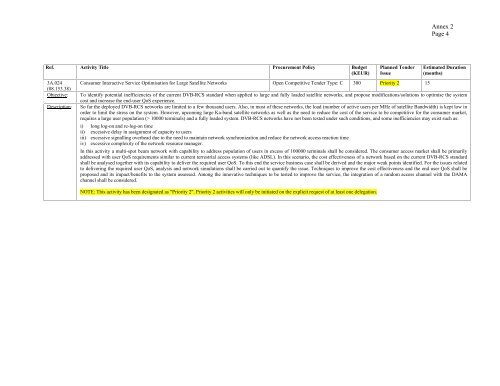ARTES-5.1 â ESA Telecom Technology Workplan ... - Emits - ESA
ARTES-5.1 â ESA Telecom Technology Workplan ... - Emits - ESA
ARTES-5.1 â ESA Telecom Technology Workplan ... - Emits - ESA
- No tags were found...
Create successful ePaper yourself
Turn your PDF publications into a flip-book with our unique Google optimized e-Paper software.
Annex 2Page 4Ref. Activity Title Procurement Policy Budget(KEUR)3A.024(08.153.38)Objective:Description:Planned TenderIssueConsumer Interactive Service Optimisation for Large Satellite Networks Open Competitive Tender Type: C 300 Priority 2 15Estimated Duration(months)To identify potential inefficiencies of the current DVB-RCS standard when applied to large and fully loaded satellite networks, and propose modifications/solutions to optimise the systemcost and increase the end-user QoS experience.So far the deployed DVB-RCS networks are limited to a few thousand users. Also, in most of these networks, the load (number of active users per MHz of satellite Bandwidth) is kept low inorder to limit the stress on the system. However, upcoming large Ka-band satellite networks as well as the need to reduce the cost of the service to be competitive for the consumer market,requires a large user population (> 10000 terminals) and a fully loaded system. DVB-RCS networks have not been tested under such conditions, and some inefficiencies may exist such as:i) long log-on and re-log-on timeii) excessive delay in assignment of capacity to usersiii) excessive signalling overhead due to the need to maintain network synchronization and reduce the network access reaction timeiv) excessive complexity of the network resource manager.In this activity a multi-spot beam network with capability to address population of users in excess of 100000 terminals shall be considered. The consumer access market shall be primarilyaddressed with user QoS requirements similar to current terrestrial access systems (like ADSL). In this scenario, the cost effectiveness of a network based on the current DVB-RCS standardshall be analysed together with its capability to deliver the required user QoS. To this end the service business case shall be derived and the major weak points identified. For the issues relatedto delivering the required user QoS, analysis and network simulations shall be carried out to quantify the issue. Techniques to improve the cost effectiveness and the end user QoS shall beproposed and its impact/benefits to the system assessed. Among the innovative techniques to be tested to improve the service, the integration of a random access channel with the DAMAchannel shall be considered.NOTE: This activity has been designated as "Priority 2". Priority 2 activities will only be initiated on the explicit request of at least one delegation.
















